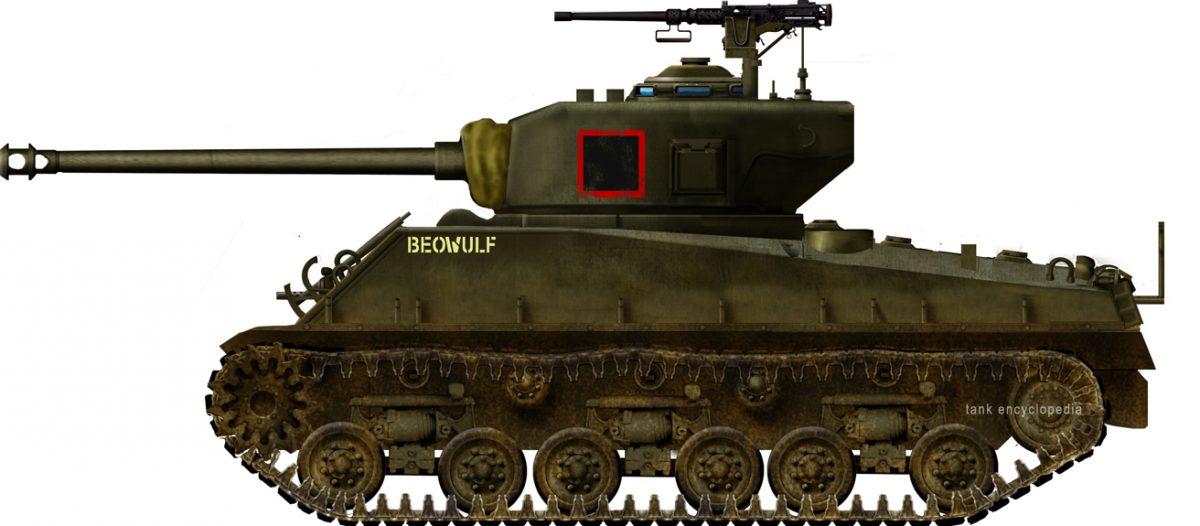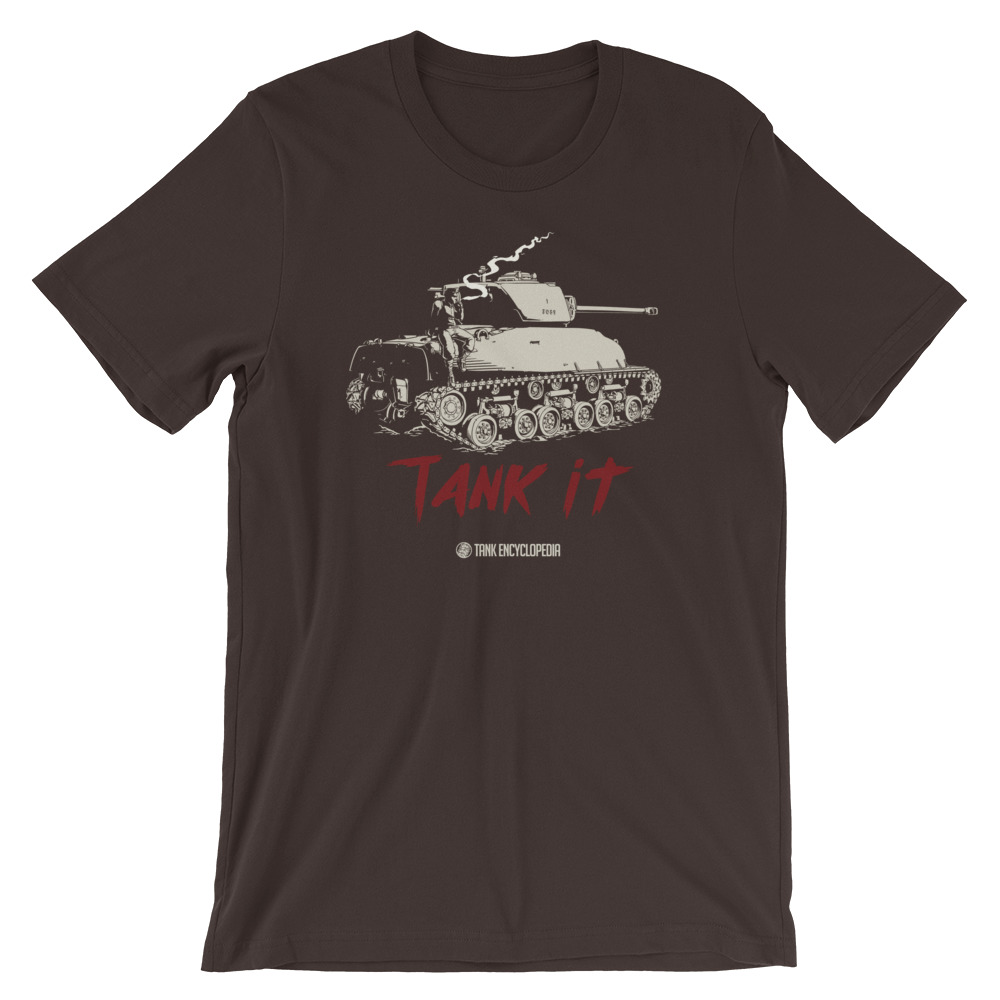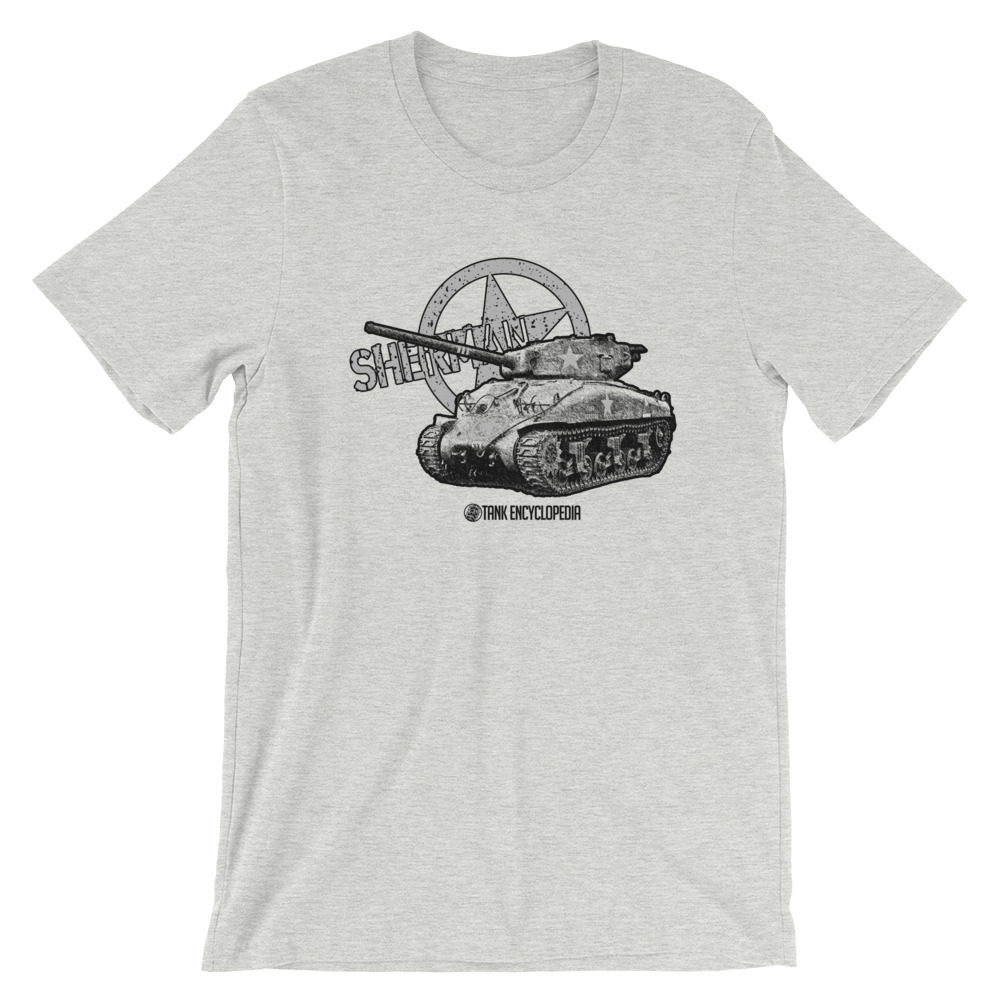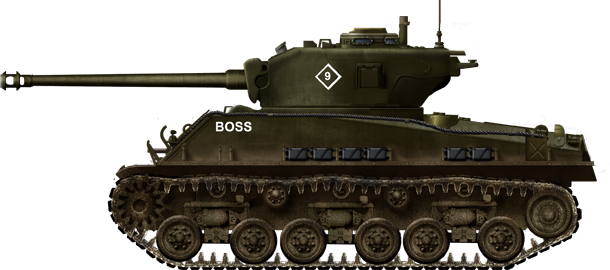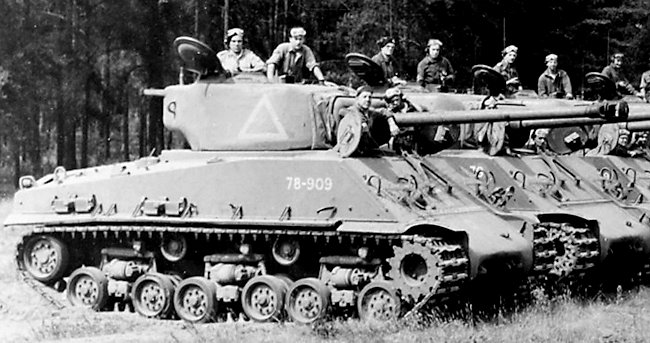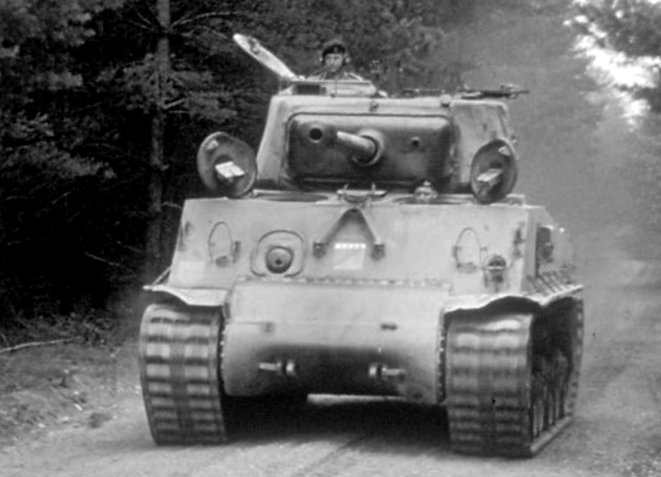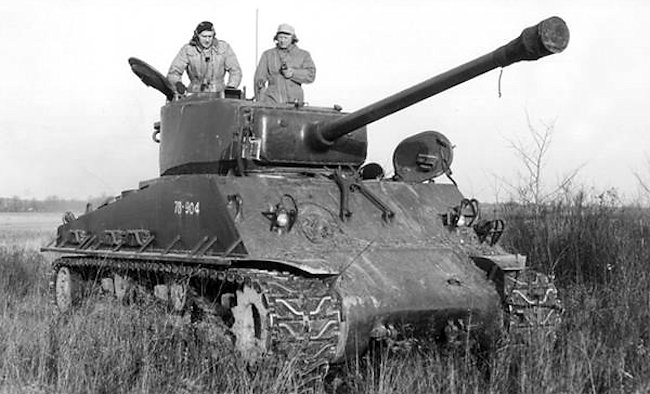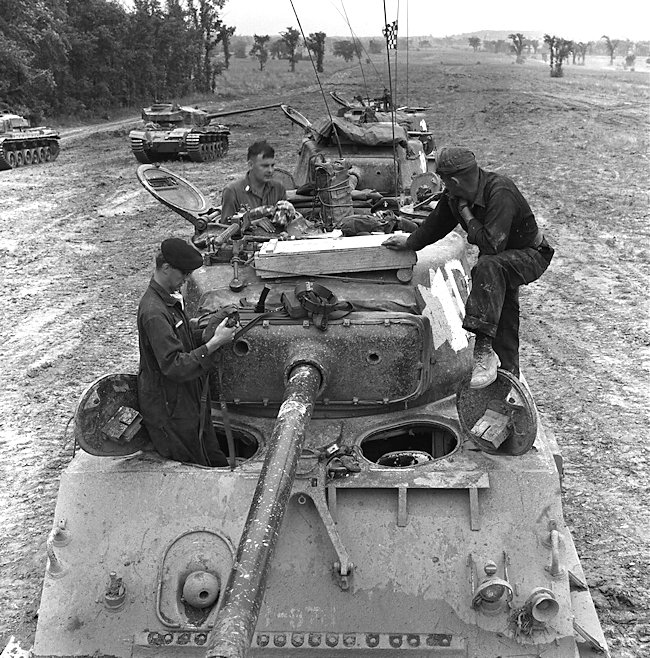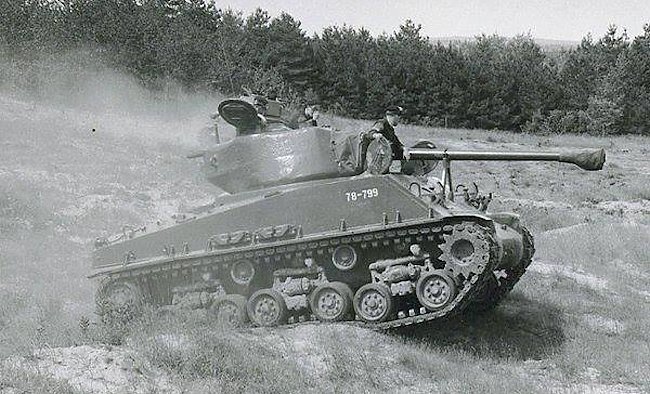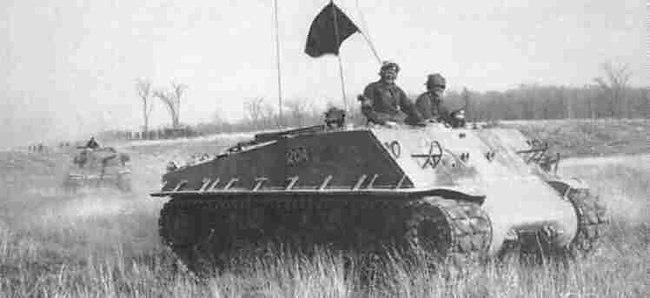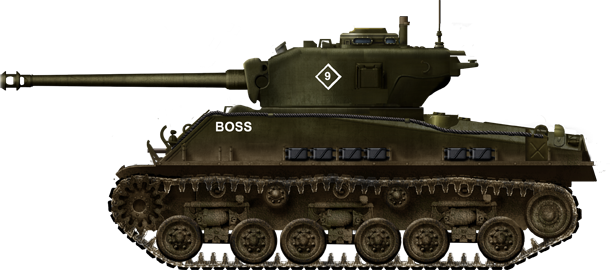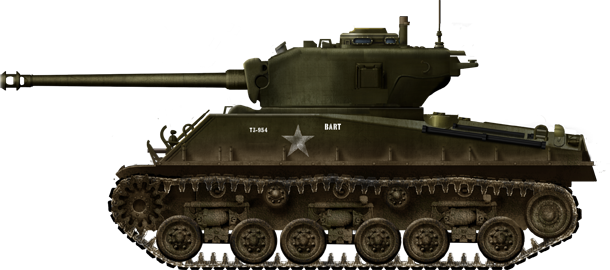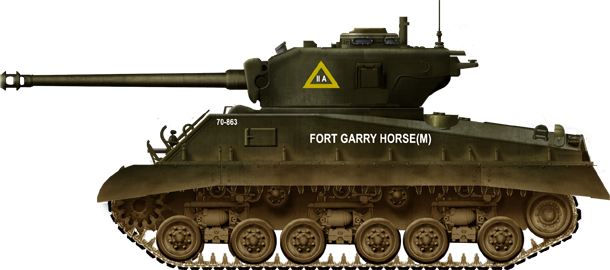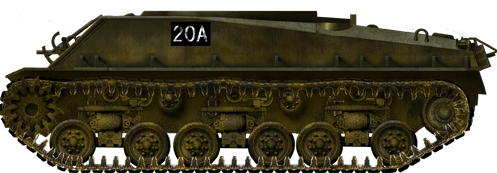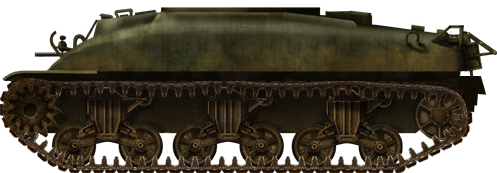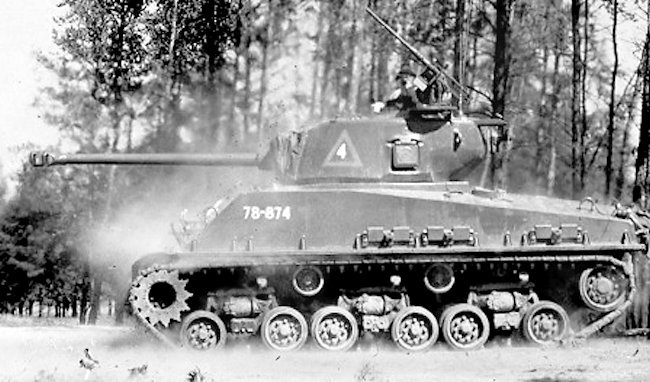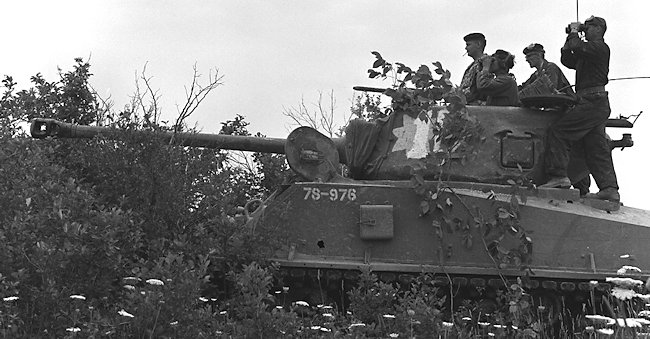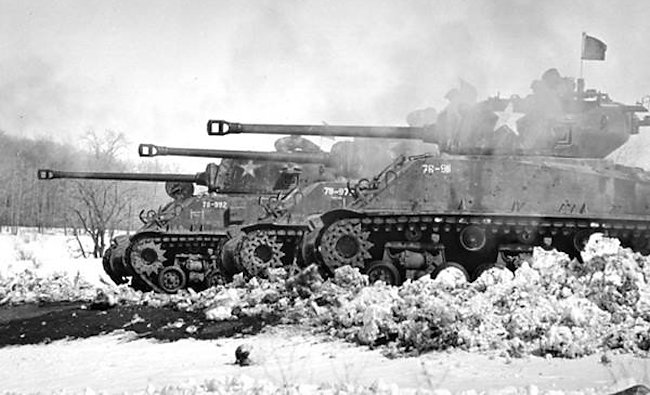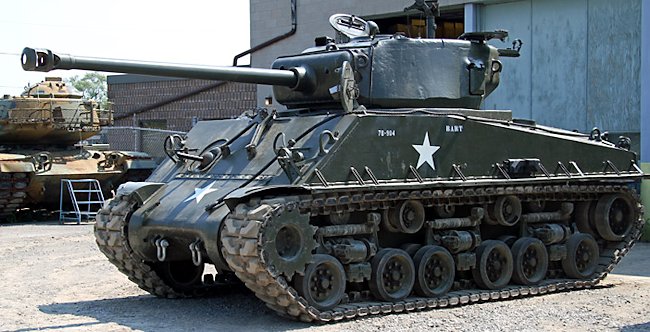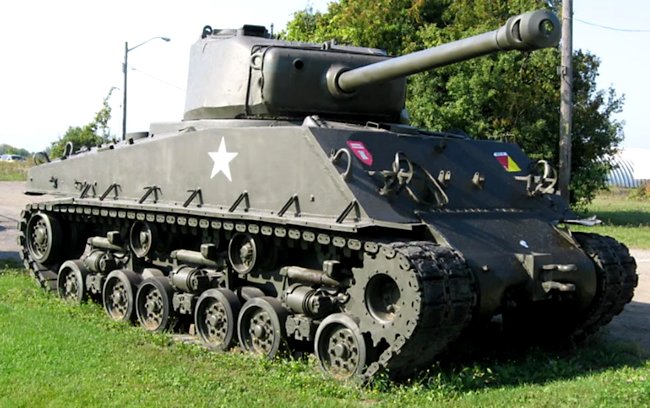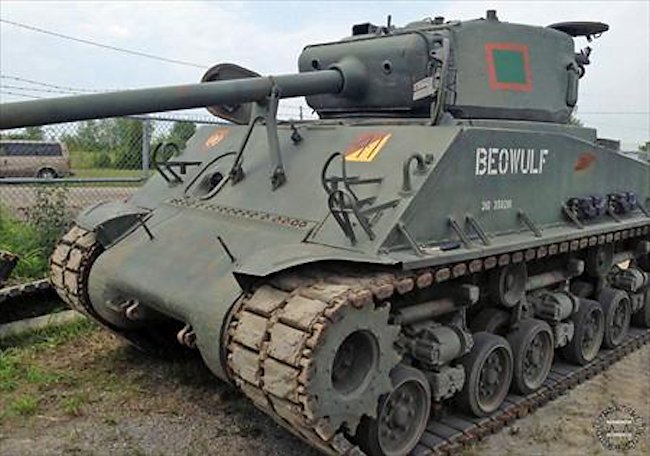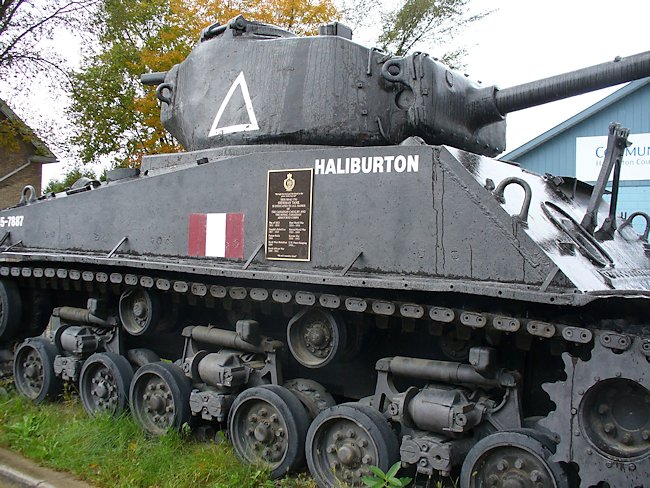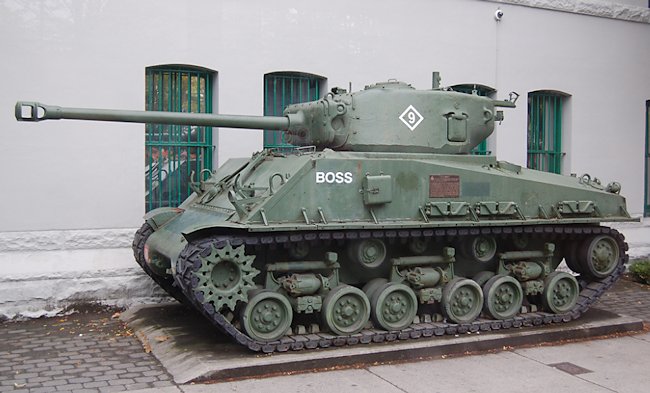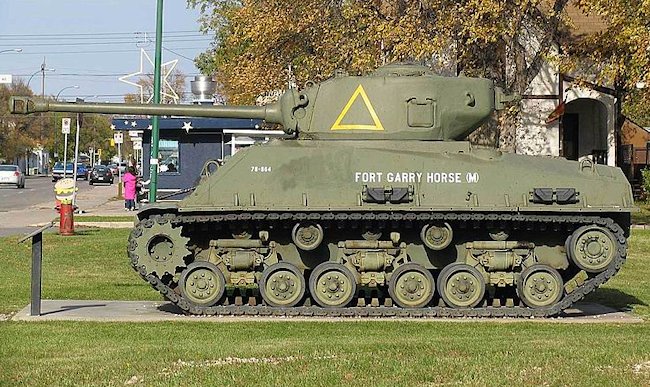 Canada (1946)
Canada (1946)
Medium Tank – 2,617 Built
Sherman M4A3(76)W with HVSS suspension
Many people call this tank the M4A3E8 -The Easy 8. The designations M4E8, M4A1E8, M4A2E8 or M4A3E8 only officially applied to prototype vehicles used to test the new HVSS (Horizontal Volute Spring System) suspension. Its experimental E8 designation led to the ‘Easy Eight’ nickname for Sherman’s so equipped. Many websites say it was because this tank was powered by a V8 engine. This is wrong. Not all the Sherman tanks given this experimental designation were powered by V8 engines.
The experimental code E8 refers to a tank fitted with Horizontal Volute Spring Suspension (HVSS) system, with wider tracks. The only production Sherman tank that had an official E designation was the up-armoured 75mm Gun Tank M4A3E2(W) – the so called Jumbo. In the American army, in the 1940’s, the letter E in the phonetically alphabet was known as ‘Easy’.
The U.S. adopted the Joint Army/Navy Phonetic Alphabet during 1941, in order to standardize systems among all branches of its armed forces. The U.S. alphabet became known as Able Baker, after the words for A and B. Today, in the 1951 International Radiotelephony Spelling Alphabet, commonly known as the NATO phonetic alphabet, the word ‘Echo’ is used when referring to the letter E.
The ‘E8’ HVSS suspension modification was an effort to improve the ride and increase the mobility of the Sherman tanks. They had progressively become heavier with increased armor and a bigger 76 mm (3 in) gun. The HVSS system used four wheels per bogie instead of two, which allowed the installation of wider tracks: 23 inches (58.42c m) compared to the normal 16 inches (40.66 cm). It did give better performance on soft ground and allowed for a smoother ride.
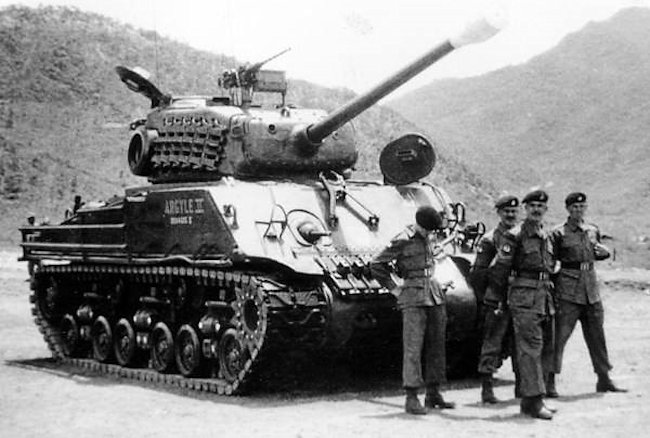
Lord Strathcona’s Horse (Royal Canadians), 2nd Armoured Regiment, Royal Canadian Armoured Corps (RCAC) tank crew with their M4A3(76)W HVSS Sherman, ‘Argyle II’ in Korea
What does the letter ‘W’ stand for?
The letter ‘W’ referred to the fire resistant wet stowage containers for the 76 mm (3 in) shells. The ammunition storage in the new tanks was improved by surrounding the racks with water and ethylene glycol-filled jackets. This was meant to reduce the probability of explosion in the event of penetration of the armor by enemy fire. The tanks equipped with this protection system were designated “Wet”.
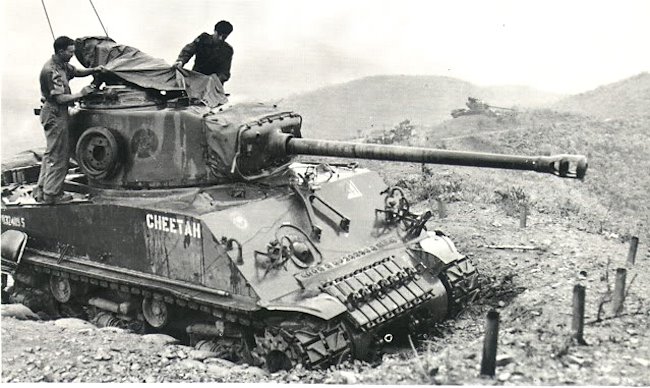
‘Cheetah’ Canadian M4A3(76)W HVSS Sherman Tank used in the Korea War armed with a 76 mm gun. Notice White Star is still visible under the circle Squadron Identity marker that was painted on top.
The main gun
The tank’s main gun was the long barreled 76 mm L/55 M1A2 fitted into the T23 turret, which could penetrate 143 millimeters (5.6 in) of unsloped rolled homogeneous armor at 100 meters (110 yd) and 97 millimeters (3.8 in) at 1,000 meters (1,100 yd) using the usual M79 round.
High-Velocity Armor Piercing (HVAP) ammunition, standardized as the M93, became available in August 1944 for the 76 mm gun. The projectile contained a tungsten core penetrator surrounded by a lightweight aluminum body, which gave it a higher velocity and more penetrating power.
One advantage that the M4A3(76) had in Korea, as opposed to WWII, was the ready availability of this High Velocity Armor Piercing ammunition. Although tank duels were rare, these shells could penetrate the Communist’s T-34/85 tank’s frontal sloping armor at normal combat ranges. The Sherman’s basic ammo load was determined by the tactical situation on the ground. The normal chosen load would consist of 41 rounds of high explosive shells, 15 rounds of White Phosphorous, 7 rounds of HVAP and 7 standard armor piercing rounds. Korean War tankers often carried many additional boxes of machine gun ammo on the exterior of their tanks.
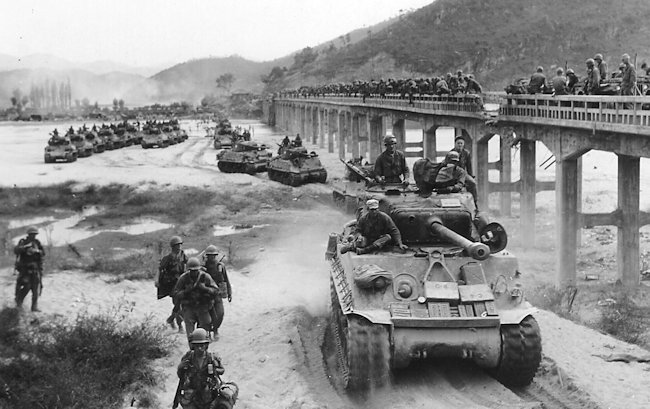
M4A3(76)HVSS of the US 72nd Heavy Tank Battalion of the 2nd Infantry Division in Korea in September 1950 fitted with T84 wide tracks
The Korean War Canadian Easy 8 Tank
In 1945, Canada left almost all its wartime vehicles in Europe rather than paying to ship them back to Canada. What little armor Canada retained was a mixture of wartime Achilles tank-destroyers as well as Grizzly and Stuart tanks which were used for training the new post WW2 tank crews.
In 1946, Canada purchased 294 M4A2(76)W HVSS Sherman Tanks from the US at the very reasonable price of $1,460 each. They had originally been intended for export to the Soviet Union under Lend-Lease, until the end of the war in Europe halted that program. These Shermans remained in Canada, where they were used as training tanks. These tanks were given DND (Department of National Defence) CFR (Canadian Forces Registration) Numbers 78-693 through 78-992. About 60 units have survived, and are on display as museum pieces and monuments throughout Canada. Data indicates that this batch of Sherman tanks were built between March 1945 through to May 1945.
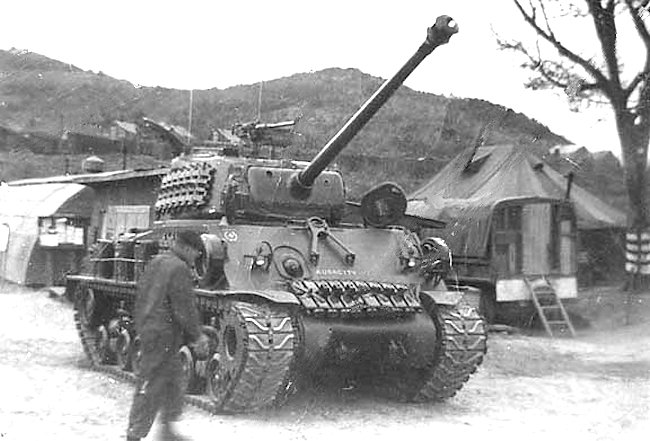
Canadian M4A3(76)W HVSS Easy 8 Sherman Tank in Korea
By spring 1950, Stalin believed the strategic situation had changed. The Soviets had detonated their first nuclear bomb in September 1949, American soldiers had fully withdrawn from Korea, the Americans had not intervened to stop the Communist victory in China, and Stalin calculated that the Americans would be less willing to fight in Korea considering the relatively small strategic significance of the country. In April 1950, Stalin gave Kim Jong Il permission to invade the South under the condition that Mao would agree to send reinforcements if they were needed. Stalin made it clear that Soviet forces would not openly engage in combat, to avoid a direct war with the Americans. At dawn on Sunday, 25 June 1950, the North Korean People’s Army crossed the 38th parallel in supposed response to South Korean troops attacking the North Koreans. The South Koreans did not have any tanks, anti-tank weapons, or heavy artillery which could halt a full-scale invasion. In addition, the South Koreans committed their forces in a piecemeal fashion, which resulted in the routing of the South Korean troops in a matter of days.
On 25 June 1950, the United Nations Security Council unanimously condemned the North Korean invasion of the Republic of Korea, with UN Security Council Resolution 82. The US rushed troops to Korea. Other United Nations forces started to arrive in South Korea to help the Americans, including the Canadians. The North Korean forces were gradually pushed back towards the Chinese Border.
On 25th October 1950 Communist Chinese troops crossed the border to help the North Korean forces.
With the outbreak of war in Korea in 1950, Canada decided to deploy an armored unit to support operations during the conflict. The first unit was a composite tank squadron, fielded as half A Squadron, Lord Strathcona’s Horse. At first, the Canadian anticipated that M10 Achilles tank destroyers, equipped with 17 pounders, would be used by their tank squadrons. The tank squadron was thus equipped with the M10’s when they landed in Puson, Korea on May 4th, 1951.
On landing, the decision was made to switch the Achilles tank destroyers for American M4A3(76)W HVSS Shermans. These tanks came from US Army and United States Marine Corps stocks already positioned in Korea. The Shermans came equipped with US radios, but the Canadian crews salvaged their No.19 sets from the M10 Achilles and retrofitted them into the borrowed tanks. Over time, extra armor was added to the tank’s hull and turret in the way of spare tracks. Some tanks were fitted with a spotlight on the turret. Another key modification was to move the .50cal mount on the turret from the back to the front of the commander’s hatch, which happened in late 1951. Some tanks from the USMC stocks had the 2 piece split commanders hatch. The now redundant M10 Achilles tank destroyers were shipped to Japan, then to the UK to be given to NATO allies.
The initial loan of 20 tanks were first crewed by the now named C Squadron of the Lord Strathcona’s Horse, which served in with the 25th Canadian Infantry Brigade. The Strathconas fielded the tank squadron rotations from 1951 till April 1954 with respective squadrons C Sqn, B Sqn , A Sqn, then to D Sqn of the Royal Canadian Dragoons. Each Squadron had 20 tanks and was comprised of four tank troops, which in turn had 4 tanks each. The Squadron headquarters would operate the four remaining tanks. This meant that the 3rd Tank Troop of D Squadron, Royal Canadian Dragoons would comprise of four M4A3(76)W HVSS Tanks (M4A3E8). This did not mean that Royal Canadian Armoured Corps four tank squadrons in Korea had access to 80 US Sherman tanks, since the Americans only loaned 20 tanks to the Canadian Forces. These tanks were issued to squadrons on a rotation basis. So when the tanks of C Squadron, the Lord Strathcona’s Horse returned from a tour of duty, they would hand them over to D Squadron, Royal Canadian Dragoons.
In the end, the Chinese and North Korean troops managed to gradually push the South Korean and UN Forces back to what is now known as the DMZ line (Demilitarized Zone) along the 38th Parallel. A stalemate ensued as troops on both sides dug in. A final armistice agreement was signed on 27 July 1953, eventually ending the service of the Canadion M4’s in Korea on April; 2954. The 20 Shermans were returned back to the Americans in November 1954.
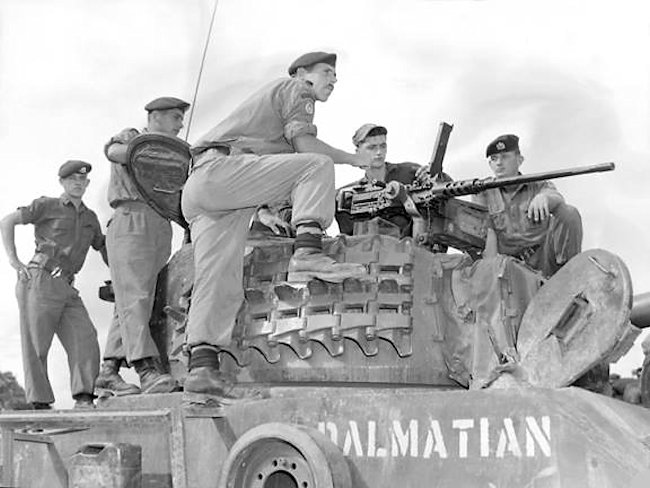
Royal Canadian Dragoon’s D Squadron M4A3(76)W HVSS Sherman tank called ‘Dalmatian’ in Korea
War time reports
Canadian Army report – ‘From the tanker’s standpoint the M4A3(75)W HVSS (M4A3E8) tank which this battalion is now equipped with has done an excellent job in Korea. However, it does possess limitations which are serious enough to warrant improvement. In general, the basic defect of the tank is its inadequate HVSS suspension system. The major complaint is that the tracks come off too easily when negotiating rough trails or when making sharp turns.’
‘A high degree of skill is required of the driver just to keep the tracks on the tank when operating over typical Korean terrain. The track itself are not strong enough to withstand the Russian type wooden box mine which is used in large numbers by the enemy. It is felt that a more rugged suspension system would withstand the blast effect of all but the multiple type enemy mines. Another criticism leveled at the present track centers around its tendency to loosen up after relatively short periods of operation’
US Army report – ‘Perhaps our greatest difficulty has been mines. North Korean minefields are invariably covered by mortar fire: the result is that usually they are located by tanks and nothing further happens until dark. (The tanks track gets damaged and cannot be recovered or fixed until it it dark). The Russian box mine containing 22lbs of TNT is extremely effective on our tanks. Being made of wood it is difficult to detect.’
‘The North Koreans and Chinese troops lay their mines at various depths so that tanks following the lead tank are blown up. There is no indication that these mines have delay type fuses.’
‘The T-34/85 tank is no problem for our present tanks to handle on an open fight. However in defensive positions dug in and camouflaged they have been very effective. Their 85mm gun will penetrate our M4A3(76)W HVSS Sherman tanks (M4A3E8) on the front slope at ranges up to 500 yards. We did have the deck of a Sherman broken through by a hit from a 120mm mortar shell. We have had no bazooka type weapons fired at us at all.’
‘The M4A3(76)W HVSS Sherman tank (M4A3E8) has been the work horse out here, far more reliable and dependable than the new M26 Pershing tank’ – W.M.Rogers, Lt Col, Armour, Headquarters 70th Tank Battalion (Heavy) Korea.
Canadian tank crew comment – ‘Funny thing is, the Canadians had no troubles with the tracks on the borrowed M4A3E8’s, the crews looked after the tanks quite well, and the drivers kept the track tension tight to avoid these issues. Most of those track issues the Americans had looks to be bad crew maintenance.’
Identification
The most obvious visual way you can tell the difference between the M4A3(76) HVSS Sherman tank and the similar looking M4A2(76) HVSS is that the M4A3(76) HVSS Sherman tank has a rectangular lump of metal sticking up from the rear deck on both sites. This was a deck cover stop. When the engine deck covers were open during maintenance they would rest on this protruding lump of metal rather than flat on the back of the tank. The M4A2(76) HVSS tank has the smaller deck covers on the rear hull and a different exhaust system.
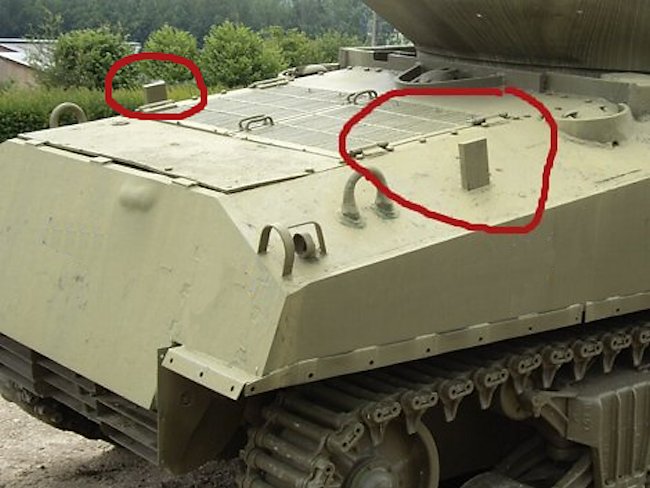
Spotting the rear deck cover stops, circled in red, are the easiest way to identify a M4A3(76)W Sherman Tank
The Lord Strathcona’s Horse (Royal Canadians), 2nd Armoured Regiment, deployed three squadrons, A, B and C, to Korea between May 1951 and May 1953. D Squadron was from the Royal Canadian Dragoons. All the tanks in A Squadron were given names that began with the letter A like ‘Argyle II’. All the tanks in B Squadron were given names that began with the letter B like ‘Beowulf’. All the tanks in C Squadron were given names that began with the letter C like ‘Cheetah’ ‘Catherine’ ‘Cassino’. All the tanks in D Squadron were given names that began with the letter D like ‘Dalmatian’ and ‘Dacshund’.
A Squadron Tanks had triangle markings on the side of the turret, B Squadron had square markings and C Squadron had circle markings. The inside was painted black to cover up the US White five pointed star. D squadron was a mixed unit but their Sherman tanks had spare tracks fitted onto the Sherman’s turret, where the Squadron marker would normally be painted. A ‘lazy D’ symbol was painted on the rear of the turret instead. The D was turned 90 degrees. The curve of the D at the bottom and the straight line of the D at the top.
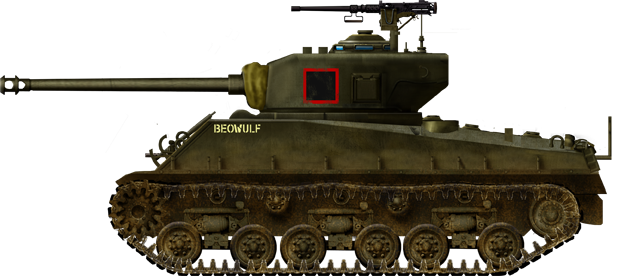
Canadian Sherman M4A3(76)W HVSS tank Beowulf, B Squadron, The Lord Strathcona’s Horse (RC), 2nd Armoured Regiment, Imjin River, Korea, August 1952.
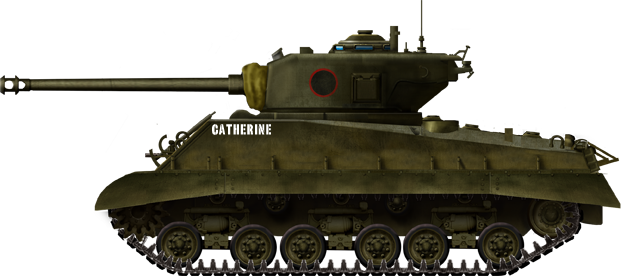
Canadian Sherman M4A3(76)W HVSS tank with markings of ‘Catherine’, C Squadron, Lord Strathcona’s Horse (Royal Canadians), 2nd Armoured Regiment, the Korean War, 16th July 1952.
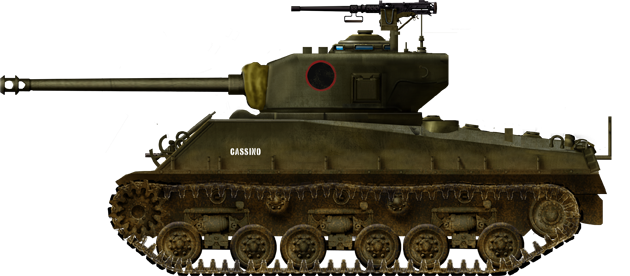
Canadian Sherman M4A3(76)W HVSS tank Cassino, C Squadron, The Lord Strathcona’s Horse (Royal Canadians), Operation Minden, Korea, September 1951
Gallery
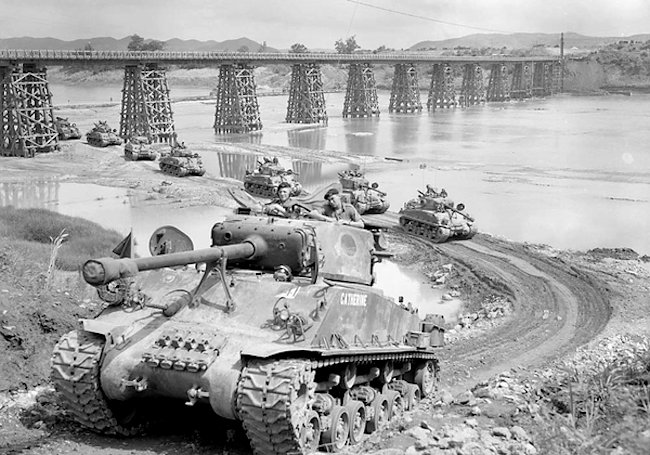
Canadian M4A3(76)W HVSS Sherman tanks of ‘C’ Squadron, Lord Strathcona’s Horse, completing a tour of front-line duty in Korea, 16 July 1952.
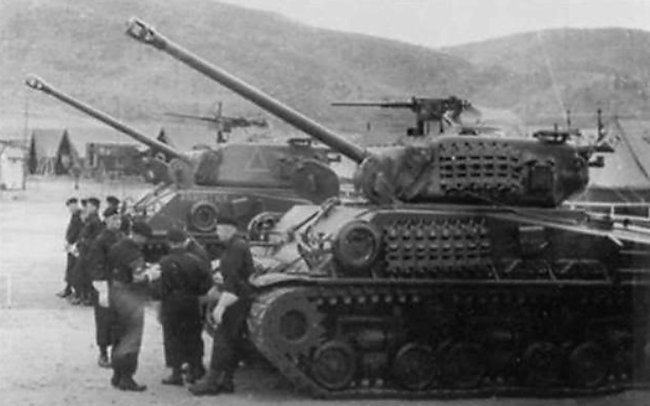
‘A’ Squadron Canadian Sherman M4A3(76)W HVSS tanks of the Lord Strathcona’s Horse (Royal Canadians), 2nd Armoured Regiment in Korea
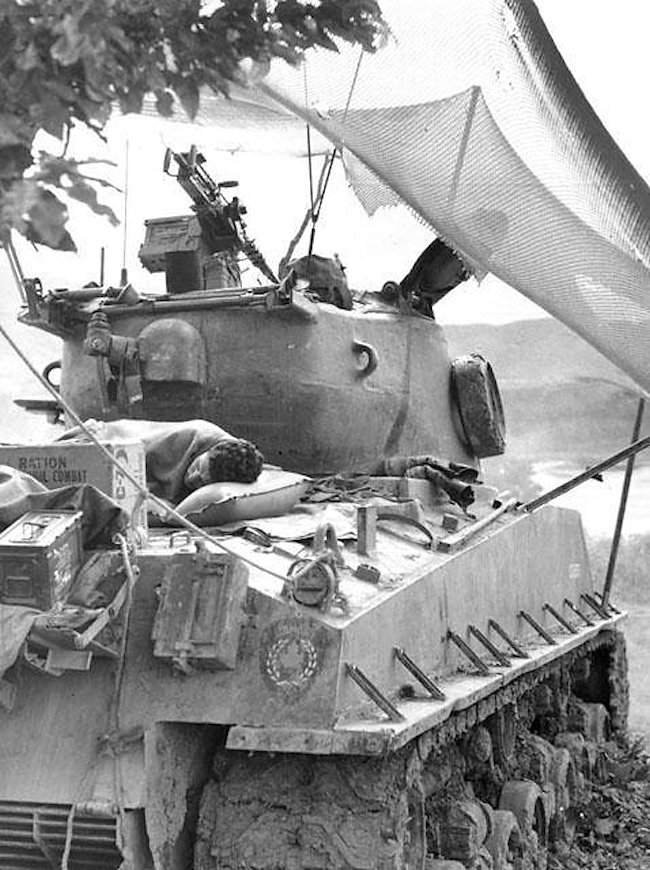
Exhausted tank crews slept whenever they could in Korea. Notice the rear deck cover stop to the right of the soldier’s head
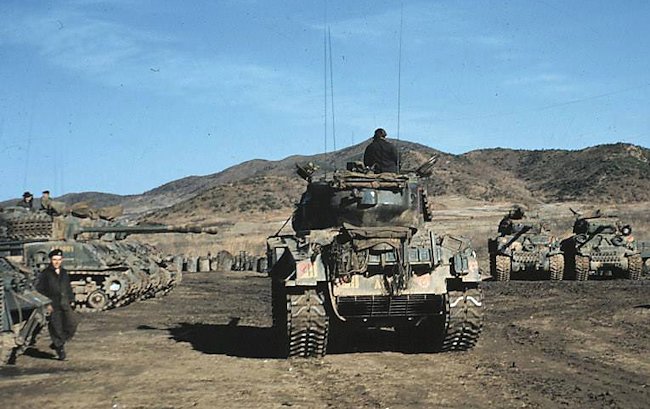
A Squadron, Lord Strathcona’s Horse (Royal Canadians) in maintenance tank park during the Korean War
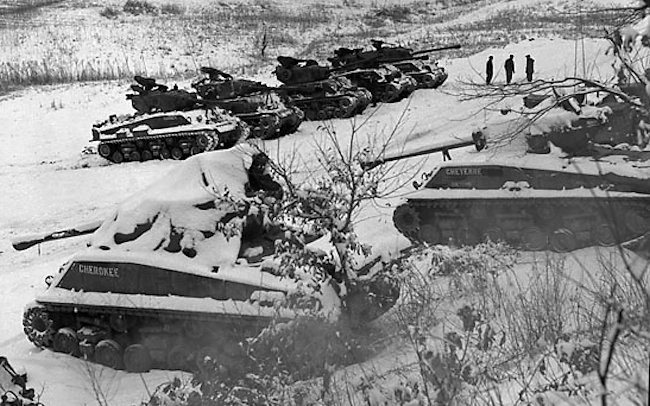
C Squadron Lord Strathcona’s Horse (Royal Canadians) in the snow during the Korean War
The crews had to cope with very cold winters in Korea. The auxiliary generator acted as a heater in these Shermans, but having the transmission in the crew compartment would have raised the temperature markedly.
Surviving Tanks
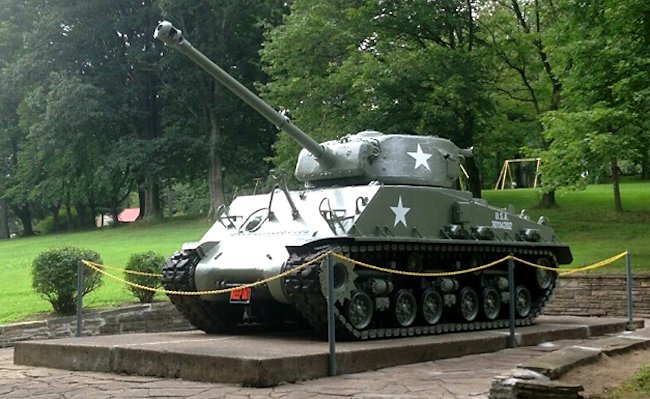
Surviving M4A3(76)W HVSS Sherman tank Serial Number 61180 was placed in a public park in Monessen, Pennsylvania, USA
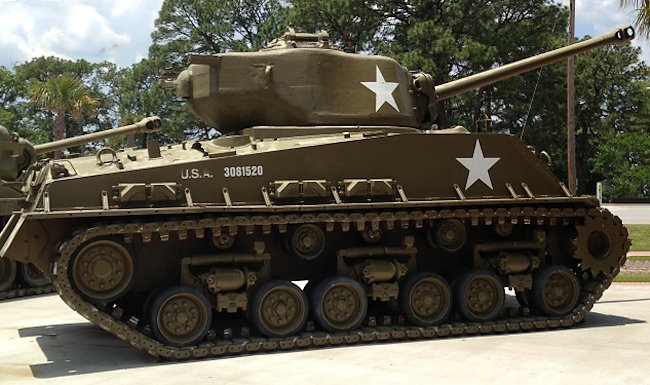
Korean War Veteran M4A3(76)W HVSS Fort Jackson, South Carolina, USA
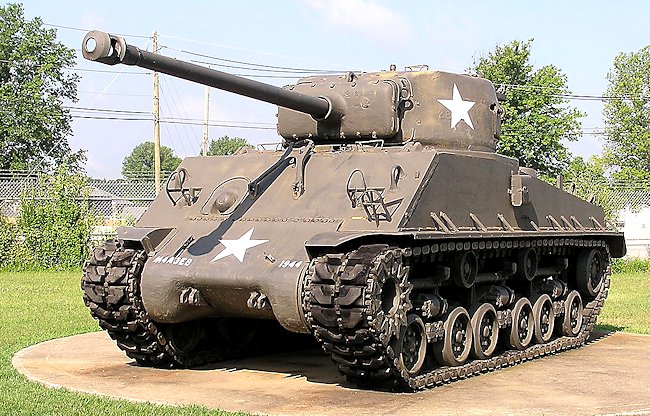
Preserved M4A3(76)W HVSS Sherman Tank, Ft. Knox, KY, USA
M4A3(76)W HVSS Sherman specifications |
|
| Dimensions (LxWxH) | 7.54 (without gun) x 2.99 x 2.97 m (24’7″ x 9’8″ x 9’7″) |
| Track width | 0.59 m (1’11” ft.in) |
| Total weight, battle ready | 30.3 tonnes (66,800 lbs) |
| Crew | 5 (commander, driver, co-driver, gunner, loader) |
| Propulsion | Ford GAA all-aluminum 32-valve DOHC 60-degree, V8 engine, 525 HP, V8 gasoline petrol engine |
| Maximum speed | 40 – 48 km/h (25 – 30 mph) on road |
| Suspensions | Horizontal Volute Spring Suspension (HVSS) |
| Range | 193 km (120 miles) |
| Armament | 76 mm (3 in) L/55 M1A12 with muzzle brake cal .50 (12.7 mm) Browning M2HB machine gun cal.30-06 (7.62 mm) Browning M1919 A4 machine gun |
| Armor | Maximum 76 mm (3 in) |
Sources
United States tanks of WW2 by George Forty
Canadian Cold War Tank History – Anthony Sewards
The Ontario Regiment (RCAC) Museum
W.M.Rogers, Lt Col, Armour, Headquarters 70th Tank Battalion (Heavy) Korea report.
Special thanks to historian Steve Osfield and retired RCAC tank crew member Anthony Sewards
Sherman Minutia, tech database (the shadocks)
M4A2(76) with HVSS on www.tank-hunter.com
“Tank-It” Shirt
Chill with this cool Sherman shirt. A portion of the proceeds from this purchase will support Tank Encyclopedia, a military history research project.
American M4 Sherman Tank – Tank Encyclopedia Support Shirt
Give ’em a pounding with your Sherman coming through! A portion of the proceeds from this purchase will support Tank Encyclopedia, a military history research project.

